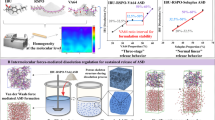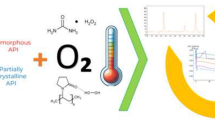Abstract
Purposes of this paper were to prepare and study new drug delivery systems for both flavanone glycosides and their aglycones based on solid-dispersion systems. These compounds are poor water soluble drugs, so an enhancement of their dissolution is a high priority. Solid-dispersion systems were prepared using PVP, PEG and mannitol as drug carrier matrices. Characterizations of these dispersions were done by differential scanning calorimeter (DSC) and X-ray diffraction (XRD). The glass transition (Tg) temperature of PVP was only recorded in the DSC thermograms of PVP solid-dispersions of both flavanone glycosides and their aglycones, while in case of PEG and mannitol solid-dispersions endotherms of both glycosides and aglycones were noticed with low peak intensity, indicating that high percent of drug is in amorphous state. The XRD patterns of all PVP solid-dispersions of aglycones show typical amorphous materials, but XRD patterns of their glycosides reveal the presence of crystalline material. However, in all solid dispersions shifts in Tg of PVP as well as Tm of PEG were observed, indicating the existence of some interactions between drugs and matrices. SEM and TEM microscopy revealed that PVP/aglycone flavanone compounds are nanodispersed systems while all the other solid dispersions are microcrystalline dispersions. The solubility of both flavanone glycosides and their aglycones was directly affected by the new physical state of solid dispersions. Due to the amorphous drug state or nano-dispersions in PVP matrices, the solubility was enhanced and found to be 100% at pH 6.8 in the nano-dispersion containing 20 mass% of aglycones. Also solubility enhancement was occurred in solid dispersions of PEG and mannitol, but it was lower than that of PVP nano-dispersions due to the presence of the drug compounds in crystalline state in both matrices.




